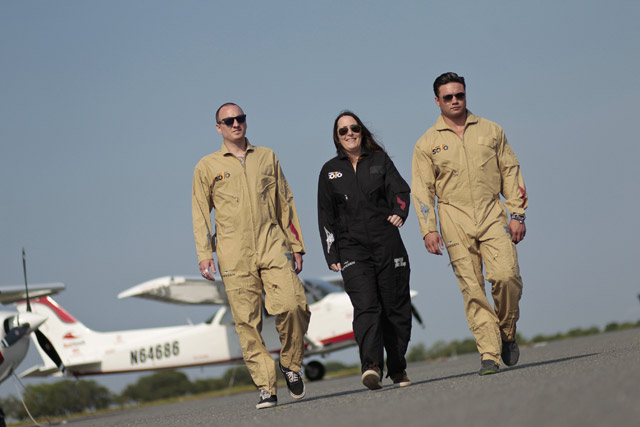
Chris Graves, Sherry Rosenkranz, and Nik Oekerman participated in the One Week Ready to Solo program.
Their instructors were silent, hands off the yoke. With only a week’s worth of experience in their logbooks, One Week Ready to Solo participants Sherry Rosenkranz, Chris Graves, and Nik Oekerman demonstrated their newfound skills with unassisted flights April 25 in Lakeland, Florida.
The project, an industry-wide effort led by Redbird Flight Simulations, brought the three students from zero flight experience to ready to solo during the week of the Sun ’n Fun International Fly-In and Expo. Instructors from award-winning flight schools took the participants through training sessions in Redbird simulators and flight lessons in diesel-engine Redbird RedHawk Cessna 172s. Throughout the week, the participants battled training plateaus, airsickness, and minor weather delays to accomplish something many people see as out of reach. They got assistance along the way from celebrity instructors, including airshow stars Sean D. Tucker, Michael Goulian, and Patty Wagstaff.
“I feel pretty good right now, I’m not going to lie,” said Graves, a Harley-Davidson engineer, after his culminating flight. His instructor, Doris Gatewood of Aviation Adventures, accompanied him with tape over her mouth to keep from offering assistance; she said the hardest part was not celebrating with Graves when he took off from the touch-and-go—because even encouraging him would be acknowledging she was there.
Roger Sharp, Redbird Skyport chief flight instructor and general manager of flight operations, said that the students would have soloed at that point if they had been training at the San Marcos, Texas, flight school. The company decided on unassisted flights because students would be performing the task in the busy Sun ’n Fun airspace, just when weekend traffic was arriving.
Graves and Rosenkranz, a global advertising manager for General Motors, made their flights from Plant City Airport to Lakeland Linder Regional Airport in Florida for a touch-and-go in front of the fly-in crowd. Oekerman, a former Navy corpsman, did three takeoffs and landings at Plant City.
“I don’t want to get out,” Rosenkranz said. “I’m kind of ready to go back up.”
Email [email protected]
View the video:
Becoming One
Eclipse Aerospace and Kestrel Aircraft are merging
By Thomas B. Haines
Two relative newcomers to aviation have come together to form ONE—ONE Aviation, that is. Eclipse Aerospace and Kestrel Aircraft are merging to create the new company, to be led by aviation innovator Alan Klapmeier. Klapmeier, a co-founder of Cirrus Aircraft, is the new CEO of ONE Aviation Corp., which will produce the Eclipse 550 twin jet and continue development of the Kestrel K350 single-engine turboprop. Klapmeier is the former CEO of Kestrel Aircraft.
“Combining the synergies of Eclipse and Kestrel under the leader of Alan Klapmeier is a perfect fit,” said Mason Holland, chairman of ONE Aviation and the former CEO of Eclipse Aerospace, the maker of the 550. Holland describes Klapmeier as “an innovator and transformational leader.”
Klapmeier said his vision includes infusing efficiencies into the companies by merging their business operations, supply chains, and marketing and sales teams. He believes his experience at Cirrus and Kestrel will allow him to continue to bring improvements to the 550. In addition, the success of the jet will help sustain his ongoing efforts to convince investors to join him in further development of the all-composite K350 turboprop, which has languished in recent years because of a lack of funding. Klapmeier bought the Kestrel project from Farnborough Aircraft in 2010. His design and engineering team have made significant airframe, interior, and panel changes to the design, and announced that it will be powered by a Honeywell TPE331-14 engine flat-rated to about 1,000 shaft horsepower. Klapmeier has never set a certification date for the project, as he sought funding from a variety of sources.
Eclipse Aviation, too, has struggled in the past. Conceived by Vern Raburn, the all-aluminum light jet was planned to be powered by Williams International engines. When the engines didn’t perform to a satisfactory level, the company switched to Pratt & Whitney PW610 engines and eventually certified the airplane, but years behind schedule and after reportedly spending $1 billion in development. Bankruptcy ensued. Holland, an Eclipse customer—and backed by some other Eclipse owners—bought the company out of bankruptcy in 2009. The new Eclipse Aerospace upgraded many of the existing 260 Eclipse 500s and, in 2013, began manufacturing a new variant called the Eclipse 550, which incorporates a number of upgrades, including autothrottles and antiskid brakes.
Email [email protected]
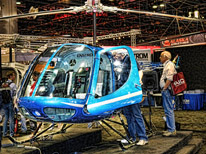
Enstrom Helicopter Corporation is developing a new TH180 training helicopter. Enstrom showcased its flight test TH180 at the 2015 Helicopter Association International’s Heli-Expo in Orlando. The helicopter took its first flight on February 6, 2015, and is powered by a 210-horsepower Lycoming HIO-390.
First Look
Tecnam debuts new single
P2010 already certified in Italy
By Ian J. Twombly
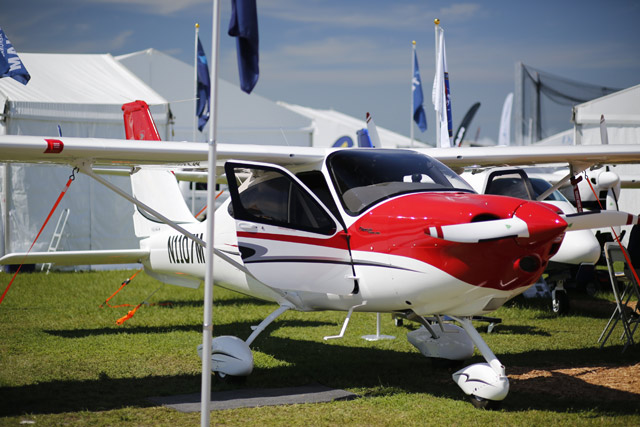
Under the philosophy of only showing off products when there’s something important to say, Tecnam used this year’s Sun ’n Fun to both introduce its production model four-seat P2010 and begin taking orders. The airplane is already certified in Europe, where 20 aircraft have been delivered to customers. FAA validation of the European Aviation Safety Agency certification is expected this September.
Despite having certified a twin-engine airplane (the P2006T) already for the U.S. market, Tecnam is still viewed by many as a Light Sport aircraft company. The single-engine P2010 should change that. It comes standard with a Garmin G1000, a Lycoming IO-360 engine, and three doors (yes, a dedicated one for the back-seaters). The company’s director of sales, Shannon Yeager, said the airplane will do 140 knots in high-speed cruise, and 125 knots when burning 7 gph to 8 gph.
Tecnam is known for building quality airplanes for the LSA market, and its reputation shows in the P2010. The fuselage is carbon fiber, the cabin is comfortable, and the airplane has a modern look.
Orders are being accepted now, and the company is offering the first 10 for an introductory price of $345,000. Regular prices are closer to $369,000.
Yeager said Sun ’n Fun also marked the one-year anniversary of the company’s U.S. sales presence. Its Sebring, Florida, facility is owned by the Italian-based manufacturer, meaning that parts availability has gotten significantly better, he said.
They’ve also taken a cue from automakers and display one of each type of aircraft in Sebring so potential customers have a chance to compare and contrast in person before deciding on which model to purchase. Once the P2010 hits the showroom, no doubt many more pilots will be coming to do just that.
Email [email protected]
View the video:
Pilatus pilot for a day—or four
‘BizAv and You’ contest under way
By Thomas B. Haines
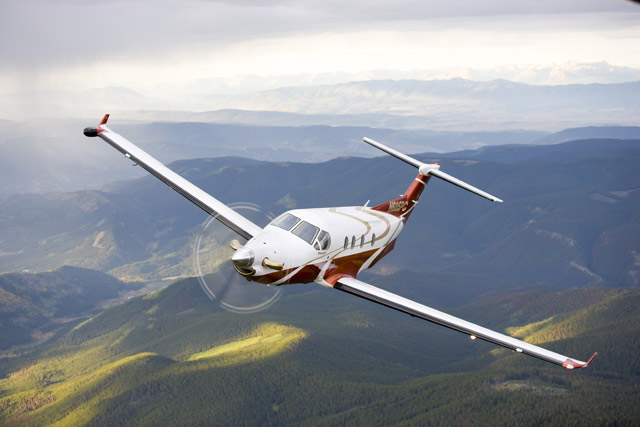
AOPA is working with Pilatus Aircraft to give a pilot a chance to fly a PC–12 NG on missions that showcase the capabilities of business aircraft. Bring along up to three friends, clients, or colleagues. We’ll document the experience in words, photos, and video and share it with AOPA members in AOPA Pilot and AOPA ePilot, on AOPA.org, and AOPA Live This Week.
The AOPA Pilot “BizAv and You Contest Powered by Pilatus” began March 1 and ends June 30. The contest is open to people who own or work for a company that would benefit from the use of a business aircraft such as the PC–12 NG. To enter, send a 300-word or less description of how your company would take advantage of a turbine business aircraft if you had access to it. The entries will be judged by the editorial staff at AOPA. Special consideration will be given to those who outline missions that take advantage of the PC–12 NG’s unique capabilities of operating off of a variety of runway surfaces, and into and out of remote areas with unusual gear.

Pilatus Aircraft will supply a PC–12 NG for up to eight hours of mission flying on up to four consecutive days—all within the contiguous 48 U.S. states. Two Pilatus corporate pilots will be on the trip. If you’re a pilot and Pilatus approves, you will get a chance to fly some of the legs. You may bring along up to three others and AOPA will bring along a writer and a photographer/videographer. The PC–12 NG seats up to 11.
Email [email protected]
Learn more about the PC-12 NG and its capabilities (www.pilatus-aircraft.com/#10).
And email those 300-word descriptions of how you’d use such an airplane in a Word document to: [email protected] before 5 p.m. Eastern time June 30, 2015.
We plan to notify the winner by July 10, 2015. The trip must be completed by September 18, 2015, at a mutually agreed upon time and place with AOPA and Pilatus.
Sun ‘n Fun news
New aircraft arriving in the United States soon include the Italian $369,000 Tecnam P2010 four-seater already making deliveries in Europe. The Flight Design C4 four-seater, not seen but talked about at Sun ‘n Fun, has flown in Europe. The news is that it will be assembled in the United States. Piper Aircraft showed a mockup of its M600 single-engine turboprop, while Mooney International is displayed a mockup of its 155-horsepower M10J diesel-powered composite aircraft. Short landing and takeoff aircraft includes the Just Aircraft SuperSTOL and the 180-horsepower American Legend Super Legend, as well as the 180-horsepower CubCrafters Carbon Cub EX-2 kitplane with new control surfaces. Rans Designs, originally intending to certify its S-20 tailwheel bush plane as a Light Sport aircraft in 2014, will do so by the end of 2015. It is currently a kitplane. Diesel power got its fair share of publicity with Piper Aircraft winning FAA approval for an European supplemental type certificate to put a Continental CD-155 engine on the Piper DX. Superior Aviation said it would offer the Gemini 100-horsepower diesel for Light Sport aircraft. It will expand to 550 horsepower for certified Part 23 aircraft in coming years. Avionics manufacturers were in the news with Avidyne providing avionics for the Sun Flyer solar-electric airplane, Aspen Avionics dropping prices on ADS-B equipment, and Avilution threatening to disrupt the industry with avionics consisting of inexpensive operating systems on low-cost mini processors. Under unusual exhibits, include an Aviat Husky on floats that can back up using a reversible propeller and a Yuneec camera-carrying drone that can go pretty much any direction it wants. —AKM
NASA tests electric airplane concepts
Could fly test aircraft in a few years
By Alton K. Marsh
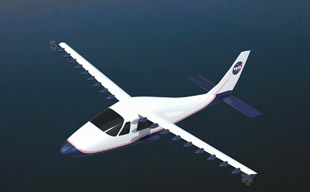 NASA’s Armstrong Flight Research Center is preparing to fly a battery-powered Tecnam twin-engine P2006T, using 18 electric motors. First comes testing of the wing and motors on the back of a modified tow truck. It will take several months to test a 31-foot-span, carbon composite wing section with motors powered by lithium iron phosphate batteries.
NASA’s Armstrong Flight Research Center is preparing to fly a battery-powered Tecnam twin-engine P2006T, using 18 electric motors. First comes testing of the wing and motors on the back of a modified tow truck. It will take several months to test a 31-foot-span, carbon composite wing section with motors powered by lithium iron phosphate batteries.
Testing on the truck will provide valuable data applicable to future flight research. Instead of being installed in a wind tunnel, the wing section will remain attached to a truss while the vehicle is driven at speeds up to 70 miles per hour across a dry lakebed at Edwards Air Force Base. Preliminary testing, up to 40 mph, took place in January at Oceano County Airport on California’s Central Coast.
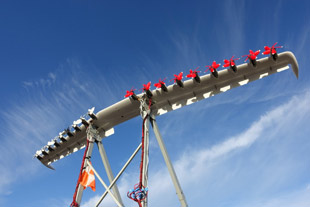 Called LEAPTech, the project began in 2014 when researchers from NASA Langley Research Center and Armstrong partnered with two California companies, Empirical Systems Aerospace (ESAero) in Pismo Beach and Joby Aviation in Santa Cruz.
Called LEAPTech, the project began in 2014 when researchers from NASA Langley Research Center and Armstrong partnered with two California companies, Empirical Systems Aerospace (ESAero) in Pismo Beach and Joby Aviation in Santa Cruz.
Researchers hope to fly a piloted X-plane by 2018 after removing the wings and engines from an Italian-built Tecnam P2006T and replacing them with an improved version of the LEAPTech wing and motors. Using an existing airframe will allow engineers to easily compare the performance of the X-plane with the original P2006T.
Each motor can be operated independently at different speeds for optimized performance. Key potential benefits of LEAPTech include decreased reliance on fossil fuels, improved aircraft performance and ride quality, and aircraft noise reduction.
Email [email protected]
NASA’s electric Tecnam P2006 (top). NASA LEAPTech demonstrator concept (above).
348-horsepower electric airplane motor developed
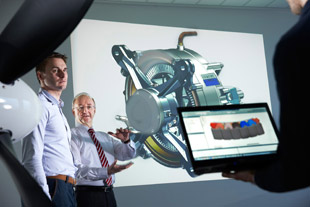 Industrial electrical firm Siemens, located in Germany, has developed a 348-horsepower electric motor that could be used in hybrid electric aircraft. The aircraft would use a gas-powered engine to drive an electrical generator.
Industrial electrical firm Siemens, located in Germany, has developed a 348-horsepower electric motor that could be used in hybrid electric aircraft. The aircraft would use a gas-powered engine to drive an electrical generator.
Extra power for takeoff would come from lithium ion batteries. In flight, turbine engines would run at cruise power using the new electric motors. Siemens has aimed its research at small airliners in conjunction with Airbus, and has flown test flights with less powerful electric engines in partnership with Diamond Aircraft. Siemens is negotiating for testing of the new motor. It isn’t known if Diamond will get the call.
Major benefits expected are fuel savings and quieter airports. Still larger electric motors will be needed for transport aircraft. The motor could be used to turn a propeller or drive a jet engine.
The goal is to develop an even more powerful electric motor of minimal weight to either replace the internal-combustion or jet engines currently used in aircraft and helicopters, or to combine those engines with an electric drive within a hybrid system. —AKM
Siemens research chief Frank Anton (center).
Eco-friendly aircraft proposed in Britain
 This one’s got it all—a biofuel engine, electric motors, solar panels, a recovery parachute, and a race-car impact cage to protect the passengers in a crash. A British company naming itself Faradair—after the electric motor genius Michael Faraday—launched a Kickstarter campaign to build a six-passenger, three-engine, tri-wing airplane. It will have a diesel engine in back driving a pusher prop and recharging batteries for two electric jet motors. It gets power from solar panels, too. However, the Kickstarter program was to have raised $31,000 by last Christmas but generated only $2,500. —AKM
This one’s got it all—a biofuel engine, electric motors, solar panels, a recovery parachute, and a race-car impact cage to protect the passengers in a crash. A British company naming itself Faradair—after the electric motor genius Michael Faraday—launched a Kickstarter campaign to build a six-passenger, three-engine, tri-wing airplane. It will have a diesel engine in back driving a pusher prop and recharging batteries for two electric jet motors. It gets power from solar panels, too. However, the Kickstarter program was to have raised $31,000 by last Christmas but generated only $2,500. —AKM
Aircraft Electronics Association news
Avionics sales up 4 percent
Topped $2.5 billion in 2014, AEA says
By Mike Collins
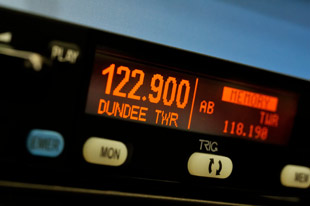 Worldwide business and general aviation avionics sales for 2014 were 4 percent higher than in 2013, according to the Aircraft Electronics Association, which released its 2014 year-end Avionics Market Report during the fifty-eighth annual AEA International Convention and Trade Show in Dallas.
Worldwide business and general aviation avionics sales for 2014 were 4 percent higher than in 2013, according to the Aircraft Electronics Association, which released its 2014 year-end Avionics Market Report during the fifty-eighth annual AEA International Convention and Trade Show in Dallas.
Total worldwide business and GA avionics sales for 2014 amounted to $2.5 billion, based on net sales prices and including all components, hardware, accessories, software upgrades, and portables for certified and noncertified aircraft. It does not include repairs, overhauls, extended warranty, or subscription services. Data was based on reports from the same 22 companies for both periods. The retrofit market accounted for 48.6 percent, a slight increase from its 46-percent market share in 2013. You can read the full report online.
FreeFlight ADS-B View 2.0
FreeFlight Systems released ADS-B View 2.0, an update to its free iPad app that displays graphical weather, traffic, and textual data that have been received by FreeFlight’s RANGR ADS-B In systems. The data is transmitted to the tablet via WiFi, and overlayed on the ADS-B View map. A new graphics engine provides increased responsiveness to user requests, including smoother scrolling and full map rotation capability. Graphical weather can be displayed in a looping mode so that weather changes can be viewed over time. In addition, multiple tablets can connect to the same transceiver, which was not possible with ADS-B View 1.0.
Trig announces coms, audio panels
Trig Avionics Limited announced two new panel-mount com radios and two audio panels. Trig’s TY96 and TY97 aviation radios operate in both 25-kHz and 8.33-kHz frequency spacings. They’re engineered into slim cases—only 1.3 inches high—that require a minimal amount of panel space.
“They’re compatible heights with existing Garmins and a bit smaller than the Bendix/King,” said Trig’s Martin Gray. However, they’re not plug compatible because these radios add stereo capability. “We like plug-compatible—our transponder is—but it didn’t seem right in this case,” he said. The TY96 transmits at 10 watts and the TY97 transmits at 16 watts. Both offer last-communication playback and an Emergency button that tunes 121.5 MHz. The memory can store 200 frequencies and identifiers; pilots can update this themselves by uploading a simple CSV file through the USB port.
The TMA44 and TMA45 audio panels offer a full feature set, supporting two com and two nav radios, and have a built-in intercom and marker beacon receiver. The TMA45 adds additional entertainment features and Bluetooth wireless support for music and mobile devices. Expected U.S. list prices are, for the TY97 aviation radio, $3,870; TY96, $3,070; TMA45 audio panel, $2,160; and TMA44, $1,280. Trig expects to be delivering them by the second half of this year.
Avidyne MLX200, MLX 210, AXP322
Avidyne Corporation has added the MLX200 and MLX210 transceivers to its ADS-B 978 Series of Automatic Dependent Surveillance-Broadcast (ADS-B) solutions. Their 978-MHz Universal Access Transceivers offer both ADS-B Out and ADS-B In capabilities. The MLX200 will display ADS-B In data on Avidyne’s IFD540 and IFD440 GPS/NAV/COMs, and also on an Avidyne EX500, EX600, or EX5000 multifunction display (MFD). The IFD540 and IFD440 provide a compliant GPS position source required for ADS-B Out. The MLX210 is the same as the MLX200, with the addition of a WAAS GPS receiver. It is designed for customers with an Avidyne EX500, EX600, or EX5000 MFD, but without an ADS-B-compatible GPS.
The MLX200 will retail for $3,495, and the MLX210 is $4,995. Prices include a connector kit; antennas are sold separately.
Avidyne’s new AXP322 Mode S transponder, which meets the ADS-B Out requirement and is designed for installation with the IFD540 or IFD440, is especially suited for aircraft with limited panel or pedestal space. It will retail for $5,450.
Email [email protected]
Giving Back
Every kid is flying
Using the power of flight to change lives
By Mike Collins

CFI Claudia Contreras, left, and student Miriam Lopez preflight
From 2,500 feet above Salinas, California, patchwork rectangles of greens and browns stretch out of sight to the north and the south. Veteran aerobatic performer Sean D. Tucker fondly calls this home. “This valley is absolutely stunning,” he said. “I spent 10,000 hours crop dusting here.”
It’s also where Tucker is actively giving back to his community, through Every Kid Can Fly. The 501(c)(3) nonprofit is using the power of flight to change the lives of at-risk and underserved teens in the Salinas Valley.
“I just love this place, and I love this community. It’s a hard-working agricultural community. We have a significant gang problem—big time. These gangs are just evil, and they capture these kids at a very young age,” he explained. “I’m getting them before they get captured by the bad guys.”
Many participants are on probation. “They’re smart, passionate, and they want to make their lives better. And we’re enabling them to do that by giving them an opportunity to take the journey to solo flight.”
The program, in its second year, starts by screening potential participants with a Young Eagles flight (Tucker is EAA’s current Young Eagles chairman). This year, 30 then had to complete a certain number of Sporty’s online ground school courses to show commitment. That brought the number down to eight.
“They will learn science, technology, engineering, and math. We don’t call it STEM, we call it flying,” Tucker said, and during 10 weeks of flight training, they will gain self-esteem.
“They’re going to learn so much—and for me, personally, it’s not important that they solo—I want them all to solo—but I want them all to go on this journey,” he said. “The most important thing we’re going to do for these kids is give them hope.”
The day before their first flight lessons, CFI Claudia Contreras worked to reassure the somewhat nervous cohort. “It’s a little intimidating,” acknowledged Contreras, a pilot since 2003 and an instructor since 2012. “I was scared when I first tried to land. It’s OK to be nervous.”
In Tucker’s hangar, she walks them through a preflight of the program’s nicely refurbished Cessna 152. Between practices of his airshow routine, Tucker pauses to high five the group and encourage them. As a 17-year-old student, “I was scared of doing stalls.” He took aerobatic lessons to lose that fear. “I got addicted—you will, too.”
Four of the eight took their first lessons with Contreras the next day. While each student showed signs of apprehension as they climbed into the Cessna, each exited with a broad smile.
Contreras said all the students did well on their first lessons. “They were very nervous. But once they got to take off, and saw that the airplane wasn’t going to fall out of the sky, I think they lost their nervousness and enjoyed the flight.”
One month later, Contreras said, all the students are working very hard. “Some are very good, and some are getting over some fears. Every one of them is highly motivated,” she said. “It is ambitious, but seeing the kids and their motivation, I think it’s something we can accomplish. I get texts and Emails about the possibility of doing extra flights.”
At press time the students had another month to fly, but a recent development might portend their future—one of last year’s participants landed a job at the airport as a mechanic.
Email [email protected]
Saving Airports
Friendly neighborhood airport
Marshfield overcomes challenges
By Jim Moore
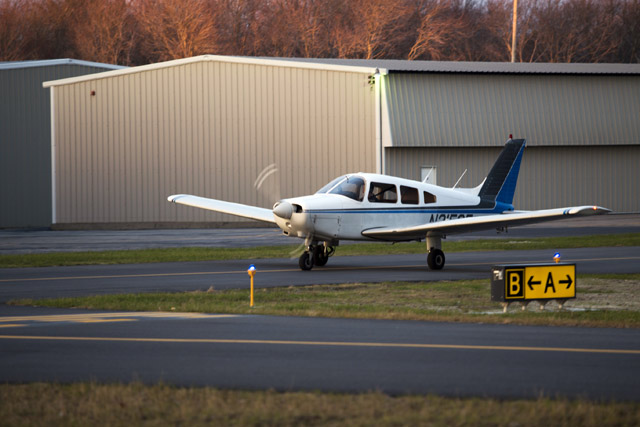
A dozen years ago, Marshfield Municipal Airport-George Harlow Field had a problem. The 3,000-foot runway was not up to modern safety standards, and had begun to decay. The airport, tucked amid marshland along the Massachusetts coastline south of Boston, needed an overhaul to secure its future. It would prove to be no easy job.
First of all, there were applications to be prepared for state and federal grants that ultimately covered most of a budget that would exceed $15 million.
As much as money, they needed patience.
The local FBO, Shoreline Aviation, took the lead on coordinating the logistics and navigating the bureaucratic processes. Shoreline Aviation President Keith Douglass managed a smile as he described two dozen turtles being fitted with GPS tracking devices so biologists could monitor their comings and goings, and confirm that the runway (with enough new pavement to extend the paved length to 3,900 feet, including overruns) and taxiways would not interfere with the turtles.
“We have a lot of turtle replication areas out here,” Douglass said, smiling, his sense of humor still, apparently, intact.
Then there was the farmhouse foundation dating to the Pilgrim era, about which archaeologists were quite enthusiastic, as Shoreline Aviation Vice President Ann Pollard recalls. The only surprise was that the artifacts were connected to European settlers rather than Native American tribes from the area.
Douglass, who paid a portion of the cost of renovating the FBO’s home, said it was worth the effort.
“It’s state-of-the-art. It’s a brand-new airport from the ramp out,” Douglass said. “It’s not that often that you see an entire, brand-new airport. We have that, now.”
Pollard said the staff learned a great deal about how to navigate the complexities of a major renovation and runway reconstruction project in the middle of a marshy wetland dotted by protected turtles and 400-year-old artifacts. One important aspect of the overall strategy remains in place—forging and maintaining strong ties to the community.
That strategy goes beyond explaining, patiently, to neighbors that no Boeing 737s would be on the way. It extends to what has become an annual “Safety Day” event that draws dozens of public service and emergency management agencies to the airport to display vehicles and meet with visitors, who arrive by the dozen. Even on a regular day, the staff will offer a tour of the newly renovated terminal building (which retains a classic New England look, and contains vestiges of an old barn within it). There is a viewing area overlooking the ramp, chairs circled around a bronze plaque set in stone that commemorates Charles Lindbergh’s famous flight—and the fact that Marshfield was the last bit of American land he saw on his crossing.
Pollard said the value of community goodwill cannot be overstated. That, along with a few tips on grant applications, wetlands construction permits, turtle behavior, and archaeological excavations are among lessons learned that Shoreline Aviation’s staff would be happy to share with other airports facing their own challenges.
Email [email protected]
Marshfield Municipal Airport-George Harlow Field (GHG)
93 Old Colony Lane
Marshfield, Massachusetts
781-834-4928
Elevation: 11 feet
Runway: 6/24; 3,900 feetby 100 feet
View the video:
This month in aviation
June 13, 1910. Charles K. Hamilton flies the Curtiss Reims Racer from New York to Philadelphia.
June 15, 1921. Bessie Coleman is the first African-American woman to receive a Federation Aeronautic Internationale pilot license.
June 17, 1928. Amelia Earhart is the first woman to fly across the Atlantic Ocean.
June 12, 1934. Air Mail Act is signed by President Franklin D. Roosevelt.
June 1, 1937. Amelia Earhart begins her around-the-world flight in a Lockheed Electra.
June 28, 1939. Pan American Airways completes first trans-Atlantic passenger flight.
June 23, 1931. Wiley Post and Harold Gatty circumnavigate the world in Winnie Mae.
June 20, 1941. U.S. Army Air Force is formed.
June 6, 1944. D-Day. A “sky-train” nine airplanes wide and 200 miles long carries American and British airborne troops to invade Europe.
June 26, 1948. The Berlin Airlift supplies the city by air.
June 11, 1957. First launch of the Atlas rocket from Cape Canaveral, Florida.
June 18, 1983. Sally Ride becomes the first female American astronaut in space when STS-7 launches from the Kennedy Space Center.
Sponsored by Breitling
Budget Buy
Cadillac with wings
Beechcraft 23 Musketeer
By Alton K. Marsh
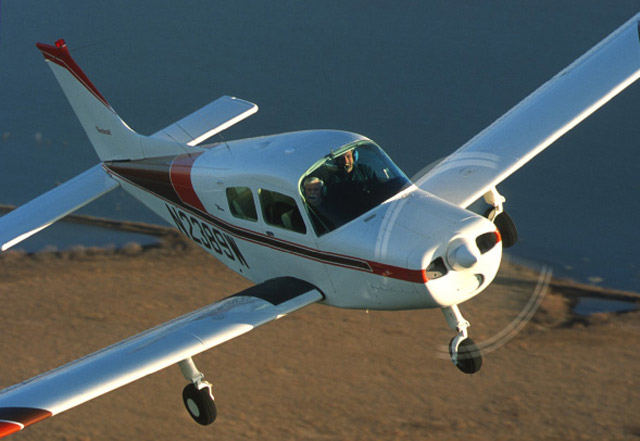
There were 2,300 Beechcraft Musketeers built in a variety of roomy models. They were considered the Cadillac of the light four-seater world. The original Model 23 came with a 160-horsepower engine, followed years later by a 180-horsepower model in 1968. There’s even a 200-horsepower model.
THE REAL WORLD
Beech Aero Club President Rap McBurney says he gets 110 knots cruise but has 60 gallons of fuel. It’s slow but goes a long way. Stability and comfort are pluses. It costs no more to own and operate than any 180-horsepower single-engine aircraft, although no specific costs were available. “It costs no more to operate than a [Cessna] 172,” McBurney said.
The 1963 model had a Lycoming O-320 engine. The next year it was replaced with the Continental IO-360, with 165 horsepower. From 1964 to 1967 the Beechcraft 23 continued with the 165-horsepower engine. There was general dissatisfaction with the engine, given that the aircraft is slow even with a 180-horsepower engine. That led to the larger engine in 1968 known as the B23 Musketeer Custom.
In 1970 the C23 emerged, also as the Musketeer Custom. In 1972 the name changed to Sundowner. When properly equipped the B23 and C23 can perform aerobatics, although it should be pointed out these are now older aircraft.
Email [email protected]
VREF value
Vref, the AOPA partner offering aircraft value estimates, suggests a base price for the Beechcraft 23 Musketeer of $20,000 for the 1963 model to $42,000 for the 1983 Beechcraft 23 Sundowner model.
Recent advertised prices
Listed in Trade-A-Plane at the time this was written were 12 Musketeer series aircraft ranging from $21,000 for a 1969 model to $38,000 for a much-coveted, 200-horsepower 1967 Custom model. Most were priced in the mid- to high 20s to low 30s.
Insurance costs
AOPA Insurance Services estimates an average-cost Musketeer 23 airframe flown by a low-time pilot will cost $700 to $900 per year to insure. www.aopainsurance.org
How many in the fleet?
AIRPAC PlaneBase shows a registered fleet of 839 Musketeer 23 series aircraft.
Financing
AOPA Finance estimates $219 per month on a 6.25- percent, 10-year loan with as little as 15 percent down. www.aopafinance.com
Airworthiness directives
No biggies. Recurring AD calls for wing bolt attachment inspections.
Biggest plus
Big on the inside—outside, too.
Biggest minus
Low cruise speed because it’s big.
Things to watch out for
Black ductwork in 1968 and later models caused corrosion.
What else to consider
Beechcraft Custom, Sundowner, or 200-horsepower Model 23-24 Musketeer Super III
Who to contact
Contact Beech Aero Club; 855-933-5923; www.beechaeroclub.org; [email protected].
Fly-Outs
Hershey, Pennsylvania
Fly in for chocolate
Courtesy of Pilot Getaways magazine

Who doesn’t love chocolate and amusement parks? The town of Hershey brings them both together, with the world’s largest chocolate manufacturing plant and Hersheypark, a world-class amusement park with more than 60 rides ranging from the tamest kiddie rides to the wildest coasters. Your Hersheypark ticket also includes admission to ZooAmerica, an 11-acre American wildlife park with over 200 North American animals. Reigle Field (58N) in nearby Palmyra is just 6 miles from all the fun. You’ll visit Chocolate World, where you tour an imaginary chocolate factory, beginning with a cocoa bean’s rainforest home and ending with a sample of sweet chocolate. Hershey Gardens, with its Butterfly House, is a must for garden lovers. How about a chocolate spa? Yes, you can relax with a Chocolate Fondue Wrap, or many other exotic treatments. Not everything is chocolate—the Circular Dining Room in the Hotel Hershey is a fine-dining, AAA Four-Diamond restaurant with an extensive wine list and wide array of seasonal delights on the dinner menu. Stay at the Hotel Hershey and you’ll be dreaming “sweet” dreams.
Hershey, Pennsylvania, is just 64 nautical miles northeast of Frederick, Maryland, so if you’re visiting AOPA for the Homecoming Fly-In June 6, make it a weekend.
EXTRA: AOPA members can get discounted access to comprehensivePilot Getaways magazine articles on great fly-out destinations by going online
If You Go
Reigle Field (58N) Palmyra, Pennsylvania
717-838-5519
www.hersheypa.com
Rental cars: www.aopa.org/cars
Fly-outs made possible by Enterprise Rent-A-Car
Avionics
Lobo:Labs launches app
Lobo:Labs has released its new FlashPass 2.1 app for iOS 7 and 8 devices. The new app integrates U.S. Customs and Border Protection’s Electronic Advance Passenger Information System (eAPIS) and Mexican APIS to make it “simple for pilots to comply with both requirements,” Arturo Guerra of Lobo:Labs said.
The app features a simple interface with top and bottom navigation tabs to let users enter passenger, pilot, crew, emergency contact, aircraft, departure, and destination information. After signing in to the app, users enter the Manifest section but can use the bottom navigation to input people, company, and aircraft information.
Lobo: Labs built the FlashPass Web interface initially to make its own eAPIS experience easier and then launched the South Texas business after pilots became interested in the service, Guerra said. So far, 2,900 pilots regularly use the FlashPass online service.
The app is free to download. U.S. eAPIS subscriptions are available for $60 a year, and Mexican APIS subscriptions for an additional $50 a year. Each offers unlimited uses. For pilots who don’t fly across the border regularly, individual manifests can be purchased for $3.99, or a pack of five manifests for $15.99. —Alyssa J. Miller
Email a[email protected]
Flight Stream
The black box that bridges the gap
By George Perry
Like thousands of general aviation cockpits, my airplane is equipped with a Garmin GNS 430W. Apart from that, there’s nothing all that modern in my panel. All the other “glass” in the panel is the old-school kind that covers traditional six-pack instruments.
As the head of AOPA’s Air Safety Institute, when I started thinking about upgrading for ADS-B compliance, a big factor in my decision was safety first—and then how to get the most bang for my buck. I knew an upgraded nav/com was off the table. I decided my trusty 430 still has lots of life left in it. I wanted TIS-B (traffic) and FIS-B (weather) for the safety benefits. With that as starting point, I began learning about options to get the benefits of both ADS-B Out and In.
About two years ago, I heard from a Garmin rep about a new gadget the company was releasing that would connect everything in the cockpit. It was called the Flight Stream 210. He explained this little black box would connect both my panel-mounted 430W, GDL 88 (ADS-B-based weather and traffic), and my iPad.
There’s no way to talk about the Flight Stream in isolation. Its purpose is to connect devices to one another wirelessly. Until recently, the problem had always been the separation between panel and portable. Portable systems are inexpensive, capable, and easy to use. Part 23 panel-mounted systems are expensive, and sometimes cumbersome to operate. With the Flight Stream as a “bridge,” it connects the two worlds of Garmin certified and portable products—and it does it seamlessly. With the Flight Stream, the Garmin Pilot electronic flight bag (EFB) iPad app talks to the Flight Stream, and the Flight Stream talks to the GDL 88 and 430W. And these communications work both ways. Make a change or update in one place (panel or portable) and the other side knows it and updates as well (with your concurrence).
I knew the Flight Stream/GDL 88 combo would give me weather and traffic on my iPad, but the real magic only became clear to me after recently filing an IFR flight plan. I filed direct and, as it often does, ATC had other ideas. After copying down a lengthy route with lots of Victor airways, I was not looking forward to programing all those points into the trusty 430. Then to my surprise, a message popped up on my iPad—it was the proposed ATC route and the exact same route clearance delivery had just given me. I simply hit “Activate” and the flight plan became active on my iPad.
Then, instead of entering dozens of points into my 430, with a push of the Transfer button, I sent the entire route (including intersections) over to the 430. I thought wow, that was easy. Later in the flight I ran into some really hard IFR conditions and with streaming AHRS data I was able to pull up the Pilot EFB’s synthetic vision screen and have a backup attitude display in addition to my certified, vacuum-driven AI. For the cost, this is about as close as you can get to a G500/1000 without having major surgery performed on your instrument panel (and your wallet). If your budget allows, there are also additional features available in Garmin’s latest GTN series nav/comm, when used with the Flight Stream.
One thing is for sure, the past several years have seen some amazing advances in the evolution of avionics and their integration. The results are encouraging, as they bring significant safety-enhancing features. I am hopeful this trend continues and opens up many more low-cost, high-utility options.
Yep, we still have to have pricey panel-mounted nav/com systems to satisfy FAA requirements, but now with Bluetooth-enabled cockpit connectivity such as what you’ll find with Flight Stream, pilots can enjoy many of the benefits of lower-cost portable solutions and have them work hand in glove with their certified counterparts.
Price: $999
Contact: www.garmin.com
Email [email protected]
The Garmin Flight Stream 210.


